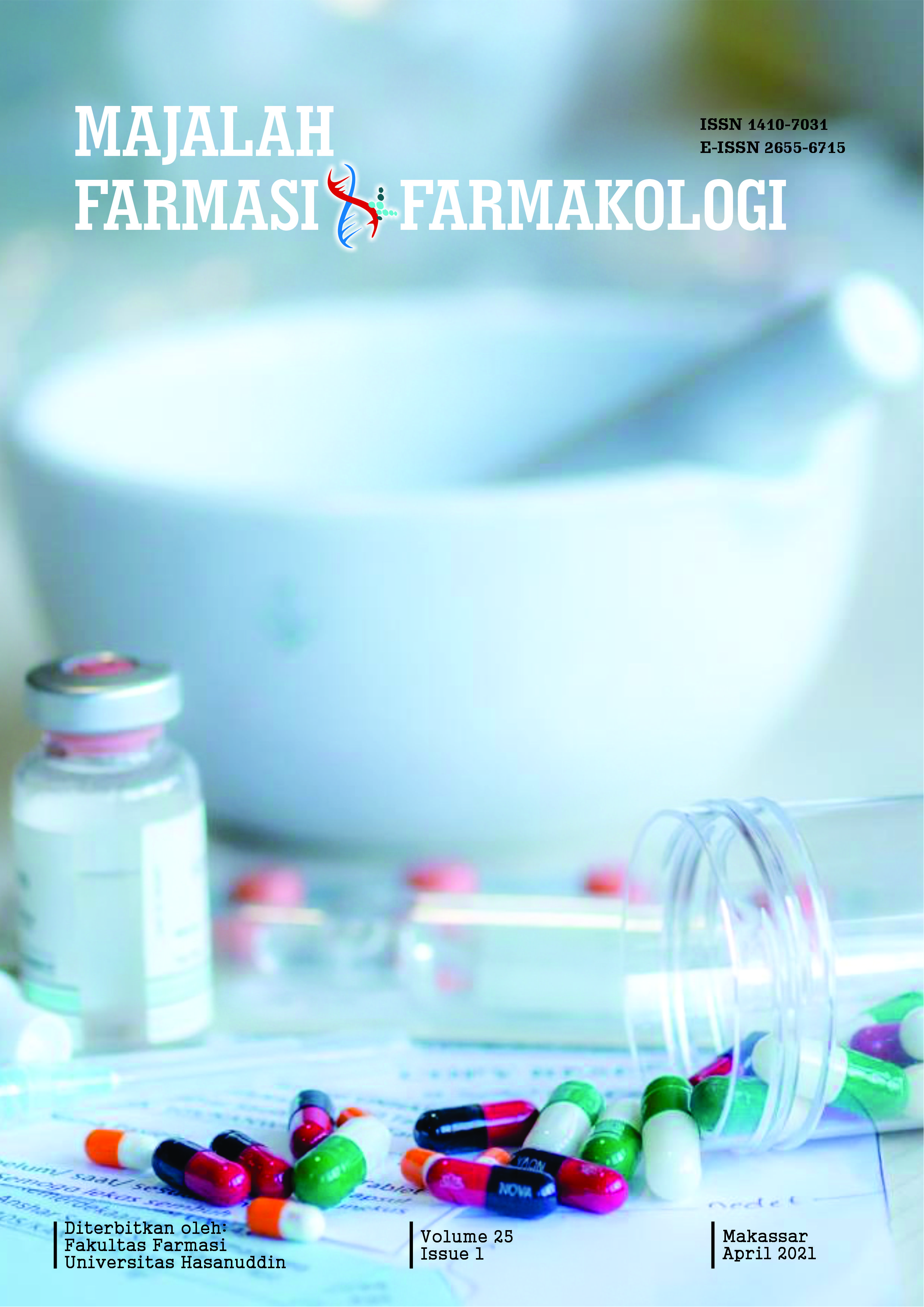PENGARUH JENIS DAN KONSENTRASI SURFAKTAN TERHADAP KARAKTERISTIK FISIK MIKROEMULSI MINYAK DEDAK PADI
Keywords:
minyak dedak padi, mikroemulsi, surfaktan, inversi fase, antioksidanAbstract
Minyak dedak padi (MDP) memiliki aktivitas antioksidan yang sangat baik sehingga berpotensi untuk
dikembangkan menjadi bahan aktif sediaan kosmetik. Di dalam penelitian ini, MDP diformulasikan ke dalam
bentuk mikroemulsi dengan variasi jenis dan konsentrasi surfaktan. MDP yang digunakan pertama-tama
dianalisis terlebih dahulu untuk memastikan identitas minyak. Setelah itu, dilakukan pengukuran aktivitas
antioksidan, di mana diperoleh nilai IC50 sebesar 239,32 μg/ml terhadap radikal bebas DPPH. Untuk formulasi
mikroemulsi, campuran surfaktan dan ko-surfaktan yang digunakan adalah Tween 80-Span 80-propilen glikol
untuk tiga formula, dan Cremophor® RH 40-gliserin untuk tiga lainnya. Mikroemulsi MDP dibuat dengan
menggunakan metode inversi fase dan setelah itu dilakukan pengamatan terhadap karakteristik fisik
mikroemulsi yang dihasilkan, meliputi organoleptis, ukuran globul, viskositas, pH, serta uji pemisahan fase.
Secara umum, formulasi yang menggunakan campuran Cremophor® RH 40-gliserin memiliki karakteristik fisik
yang lebih baik, Ukuran globul mikroemulsi yang dihasilkan dengan campuran Cremophor® RH 40-gliserin
berkisar 21,32 – 24,10 nm dengan indeks polidispersitas <0,3 yang menunjukkan homogenitas ukuran globul
yang baik. Hasil uji pemisahan fase juga menunjukkan bahwa formulasi yang menggunakan Cremophor® RH
40-gliserin lebih stabil dan tidak mengalami pemisahan fase setelah sentrifugasi.
References
Sanches Silveira JEP, Myaki Pedroso DM. UV light and skin aging. Reviews on Environmental Health. 2014;29(3):243-54.
Panich U, Sittithumcharee G, Rathviboon N, Jirawatnotai S. Ultraviolet Radiation-Induced Skin Aging: The Role of DNA Damage and Oxidative Stress in Epidermal Stem Cell Damage Mediated Skin Aging. Stem Cells International. 2016;2016:7370642.
He H, Li A, Li S, Tang J, Li L, Xiong L. Natural components in sunscreens: Topical formulations with sun protection factor (SPF). Biomedicine & Pharmacotherapy. 2021;134:111161.
Rigo LA, Pohlmann AR, Guterres SS, Ruver Beck RC. Chapter 23 - Rice Bran Oil: Benefits to Health and Applications in Pharmaceutical Formulations. In: Watson RR, Preedy VR, Zibadi S, editors. Wheat and Rice in Disease Prevention and Health. San Diego: Academic Press; 2014. p. 311-22.
Rungratanawanich W, Abate G, Uberti D. Chapter 20 - Pharmacological profile of γ-oryzanol: Its antioxidant mechanisms and its effects in age-related diseases. In: Preedy VR, Patel VB, editors. Aging (Second Edition): Academic Press; 2020. p. 201-8.
Manosroi A, Chutoprapat R, Sato Y, Miyamoto K, Hsueh K, Abe M, et al. Antioxidant activities and skin hydration effects of rice bran bioactive compounds entrapped in niosomes. Journal of nanoscience and nanotechnology. 2011;11(3):2269-77.
Rigo LA, da Silva CR, de Oliveira SM, Cabreira TN, de Bona da Silva C, Ferreira J, et al. Nanoencapsulation of rice bran oil increases its protective effects against UVB radiation-induced skin injury in mice. European Journal of Pharmaceutics and Biopharmaceutics. 2015;93:11-7.
Singh K, Iqubal MK, Shukla VK, Shuaib M. Review Article Microemulsions: Current Trends in Novel Drug Delivery Systems. 2014;1:39-5139.
Shukla T, Upmanyu N, Agrawal M, Saraf S, Saraf S, Alexander A. Biomedical applications of microemulsion through dermal and transdermal route. Biomedicine & Pharmacotherapy. 2018;108:1477-94.
Singh V, Bushettii SS, Raju SA, Ahmad R, Singh M, Bisht A. Microemulsions as Promising Delivery Systems: A Review. Indian Journal of Pharmaceutical Education and Research. 2011;45(4):392-401.
Grampurohit N, Ravikumar P, Mallya R. Microemulsions For Topical Use– A Review. Indian Journal of Pharmaceutical Education and Research. 2010;45(1):100-7.
Kaur G, Mehta SK. Developments of Polysorbate (Tween) based microemulsions: Preclinical drug delivery, toxicity and antimicrobial applications. International Journal of Pharmaceutics. 2017;529(1):134-60.
Olariu I, Coneac G, Vlaia L, Vlaia V, Anghel DF, Ilie C, et al. Development and Evaluation of Microemulsion-Based Hydrogel Formulations for Topical Delivery of Propranolol Hydrochloride. Digest Journal of Nanomaterials and Biostructures. 2014;9(1):395 - 412.
BSN. Cara uji minyak dan lemak (SNI 01-3555-1998). SNI. Jakarta: Badan Standardisasi Nasional; 1998. p. 31.
Moko EM, Purnomo H, Kusnadi J, Ijong FG. Phytochemical content and antioxidant properties of colored and non colored varieties of rice bran from Minahasa, North Sulawesi, Indonesia. International Food Research Journal. 2014;21(3):1053-9.
Valoppi F, Frisina R, Calligaris S. Fabrication of Transparent Lemon Oil Loaded Microemulsions by Phase Inversion Temperature (PIT) Method: Effect of Oil Phase Composition and Stability after Dilution. Food Biophysics. 2017;12(2):244-9.
Hartono HOS, Soetjipto H, Kristijanto AI. Extraction and Chemical Compounds Identification of Red Rice Bran Oil Using Gas Chromatography – Mass Spectrometry (GC-MS) Method. Eksakta: Jurnal Ilmu-ilmu MIPA. 2017;17(2):98-110.
Wen TX. Extraction and Analysis of Antioxidant Capacity in Rice Bran Extracts from Different Sarawak Local Rice Varieties. Malaysia: Swinburne University of Technology; 2015.
Chen J, Ma X-h, Yao G-l, Zhang W-t, Zhao Y. Microemulsion-based anthocyanin systems: effect of surfactants, cosurfactants, and its stability. International Journal of Food Properties. 2018;21(1):1152-65.
Ngawhirunpat T, Worachun N, Opanasopit P, Rojanarata T, Panomsuk S. Cremophor RH40-PEG 400 microemulsions as transdermal drug delivery carrier for ketoprofen. Pharmaceutical development and technology. 2013;18(4):798-803.
Ita K. Chapter 6 - Microemulsions. In: Ita K, editor. Transdermal Drug Delivery: Academic Press; 2020. p. 97-122.
Salatin S, Maleki Dizaj S, Yari Khosroushahi A. Effect of the surface modification, size, and shape on cellular uptake of nanoparticles. Cell biology international. 2015;39(8):881-90.
Patel RB, Patel MR, Bhatt KK, Patel BG. Formulation consideration and characterization of microemulsion drug delivery system for transnasal administration of carbamazepine. Bulletin of Faculty of Pharmacy, Cairo University. 2013;51(2):243-53.
Mahmoud H, Al-Suwayeh S, Elkadi S. Design and optimization of self-nanoemulsifying drug delivery systems of simvastatin aiming dissolution enhancement. African Journal of Pharmacy and Pharmacology. 2013;7(22):1482-500.
Tang H, Xiang S, Li X, Zhou J, Kuang C. Preparation and in vitro performance evaluation of resveratrol for oral self-microemulsion. PLoS One. 2019;14(4):e0214544.
Fitriani EW, Imelda E, Kornelis C, Avanti C. Karakterisasi dan Stabilitas Fisik Mikroemulsi Tipe A/M dengan Berbagai Fase Minyak. Pharmaceutical Science Research. 2016;3(1):31-44.
Kuo S-H, Shen C-J, Shen C-F, Cheng C-M. Role of pH Value in Clinically Relevant Diagnosis. Diagnostics (Basel). 2020;10(2):107.
Downloads
Published
Issue
Section
License
Copyright (c) 2021 Majalah Farmasi dan Farmakologi

This work is licensed under a Creative Commons Attribution-NonCommercial 4.0 International License.
The copyright to this article is transferred to Universitas Hasanuddin (UNHAS) if and when the article is accepted for publication. The undersigned hereby transfers all rights in and to the paper including without limitation all copyrights to UNHAS. The undersigned hereby represents and warrants that the paper is original and that he/she is the author of the paper, except for material that is clearly identified as to its original source, with permission notices from the copyright owners where required. The undersigned represents that he/she has the power and authority to make and execute this assignment.
We declare that:
- This paper has not been published in the same form elsewhere.
- It will not be submitted anywhere else for publication prior to acceptance/rejection by this Journal.
- A copyright permission is obtained for materials published elsewhere and which require this permission for reproduction.
Furthermore, I/We hereby transfer the unlimited rights of publication of the above-mentioned paper in whole to UNHAS The copyright transfer covers the exclusive right to reproduce and distribute the article, including reprints, translations, photographic reproductions, microform, electronic form (offline, online) or any other reproductions of similar nature.
The corresponding author signs for and accepts responsibility for releasing this material on behalf of any and all co-authors. This agreement is to be signed by at least one of the authors who have obtained the assent of the co-author(s) where applicable. After submission of this agreement signed by the corresponding author, changes of authorship or in the order of the authors listed will not be accepted.


